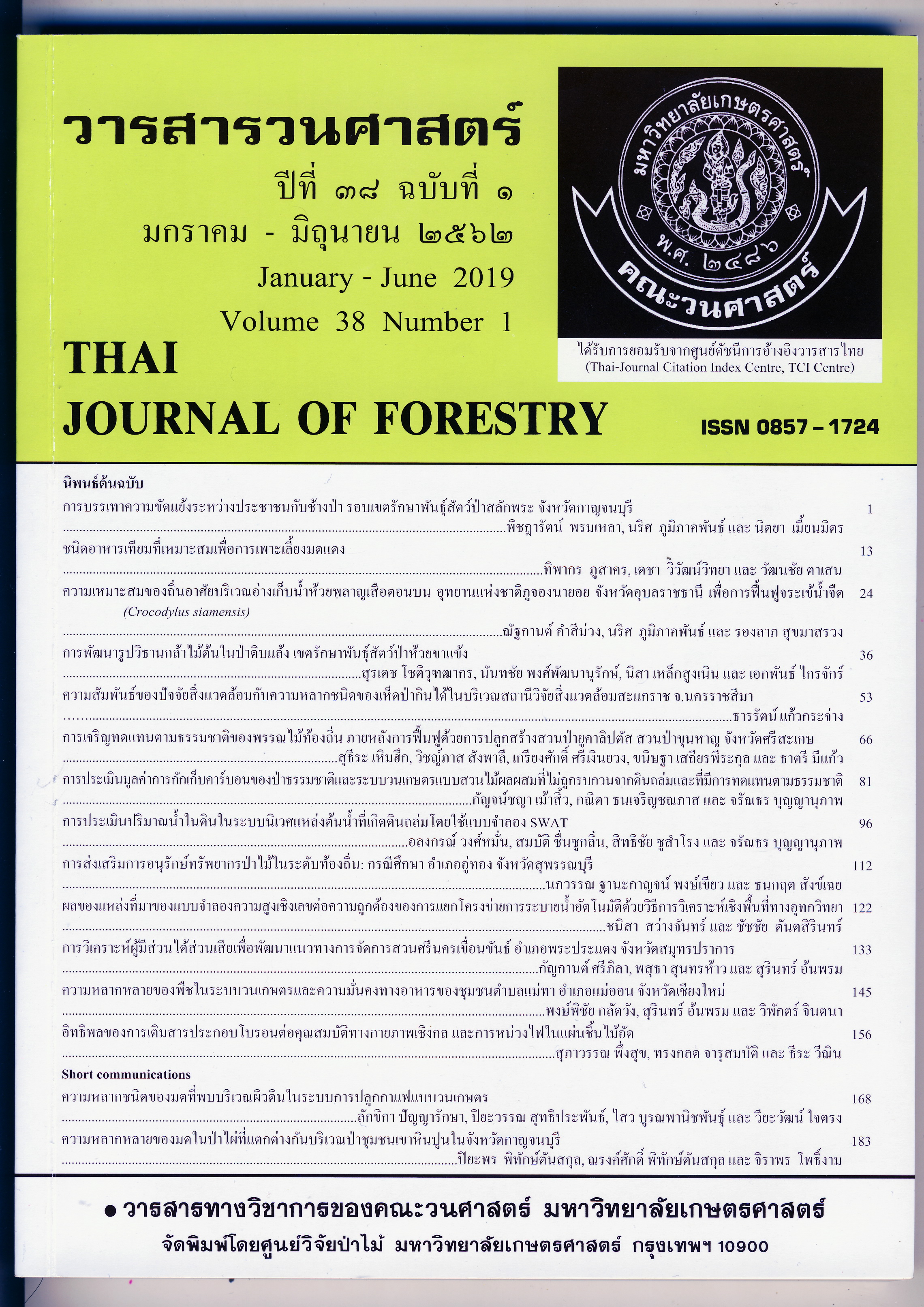ชนิดอาหารเทียมที่เหมาะสมเพื่อการเพาะเลี้ยงมดแดง
Main Article Content
บทคัดย่อ
มดแดง (Oecophylla smaragdina Fabricius) เป็นแมลงกินได้ที่มีความสำคัญทางเศรษฐกิจในประเทศไทย ทำให้ประชาชนเกิดความสนใจในการเพราะเลี้ยงเพิ่มมากขึ้น การเพาะเลี้ยงมดแดงจำเป็นต้องคำนึงถึงหลายเรื่องรวมถึงอาหารสำหรับเลี้ยงมดแดง อาหารเทียมจึงมีความสำคัญในการเพาะเลี้ยงมดแดง เพื่อต้องการทราบสูตรอาหารเทียมที่ดีสำหรับการเพาะเลี้ยงมดแดง จึงได้สร้างอาหารเทียมขึ้นมาทั้งสิ้น 6 สูตร โดยแบ่งออกเป็นอาหารวุ้น 3 สูตร ได้แก่ อาหารวุ้นสูตรหมู อาหารวุ้นสูตรปลา อาหารวุ้นสูตรจิ้งหรีด และอาหารแป้ง 3 สูตร ได้แก่ อาหารแป้งสูตรหมู อาหารแป้งสูตรปลา อาหารแป้งสูตรจิ้งหรีด โดยทดลองให้อาหารเทียมกับมดงานในธรรมชาติและห้องปฏิบัติการ รวมทั้งเลี้ยงตัวอ่อนของมดแดงด้วยอาหารเทียมทั้ง 6 สูตร การศึกษาพบว่าอาหารวุ้นสูตรจิ้งหรีด และอาหารวุ้นสูตรปลา มีมดงานเข้ากินมากกว่าอาหารสูตรอื่น ทั้งในพื้นที่ธรรมชาติและห้องปฏิบัติการ เนื่องจากกลิ่น การละลายของวุ้น และความนิ่มของเนื้อวุ้น การเข้ากินอาหารของมดแดงในธรรมชาติเป็นการค่อยๆ เข้ากินแตกต่างกับในห้องปฏิบัติการคือมดแดงเข้ากินทันทีเมื่อเริ่มให้อาหาร เมื่อเปรียบเทียบพบว่ามดงานเข้ากินอาหารเทียมในห้องปฏิบัติการมากกว่าในธรรมชาติ การเข้ากินอาหารเทียมแต่ละช่วงเวลาของมดงานทั้งสองพื้นที่พบว่าแตกต่างกันอย่างมีนัยสำคัญทางสถิติที่ P<0.05 ตัวอ่อนที่เลี้ยงด้วยอาหารวุ้นสูตรจิ้งหรีดมีอัตราการรอดมากที่สุด คิดเป็นร้อยละ 88.33 ตัวอ่อนทุกระยะรอดตายมากกว่าร้อยละ 80 และระยะดักแด้รอดตายมากที่สุดคิดเป็นร้อยละ 99.72
Downloads
Article Details
ข้าพเจ้าและผู้เขียนร่วม (ถ้ามี) ขอรับรองว่า ต้นฉบับที่เสนอมานี้ยังไม่เคยได้รับการตีพิมพ์และไม่ได้อยู่ในระหว่างกระบวนการพิจารณาตีพิมพ์ลงในวารสารหรือสิ่งตีพิมพ์อื่นใด ข้าพเจ้าและผู้เขียนร่วม (ถ้ามี) ยอมรับหลักเกณฑ์และเงื่อนไขการพิจารณาต้นฉบับ ทั้งยินยอมให้กองบรรณาธิการมีสิทธิ์พิจารณาและตรวจแก้ต้นฉบับได้ตามที่เห็นสมควร พร้อมนี้ขอมอบลิขสิทธิ์ผลงานที่ได้รับการตีพิมพ์ให้แก่วารสารวนศาสตร์ คณะวนศาสตร์ มหาวิทยาลัยเกษตรศาสตร์ กรณีมีการฟ้องร้องเรื่องการละเมิดลิขสิทธิ์เกี่ยวกับภาพ กราฟ ข้อความส่วนใดส่วนหนึ่ง หรือ ข้อคิดเห็นที่ปรากฏในผลงาน ให้เป็นความรับผิดชอบของข้าพเจ้าและผู้เขียนร่วม (ถ้ามี) แต่เพียงฝ่ายเดียว และหากข้าพเจ้าและผู้เขียนร่วม (ถ้ามี) ประสงค์ถอนบทความในระหว่างกระบวนการพิจารณาของทางวารสาร ข้าพเจ้าและผู้เขียนร่วม (ถ้ามี) ยินดีรับผิดชอบค่าใช้จ่ายทั้งหมดที่เกิดขึ้นในกระบวนการพิจารณาบทความนั้น”
เอกสารอ้างอิง
2014. Formulation of artificial diet to increase
population distribution and aggressive behavior
of Weaver Ant (Oecophylla Smaragdina F.) for
controling Cocoa Pod Borer (Conopomorpha
Cramerella Sn.). Academic Research
International 5 (5): 1-10.
Hölldobler B. and E.D. Wilson 1977. These social
insect use their own larvae as shuttles to
weave leaves into large nest in the rain
forests of Africa and Asia. Their behavior
is coordinated by complex chemical stimuli.
Scientific American. 1: 146-154.
วารสารวนศาสตร์ 38 (1) : 13-23 (2562) 23
Lokkers, C. 1990. Colony Dynamics of the Green
Tree Ant (Oecophylla smaragdina Fab.) in
a Seasonal Tropical Climate. Ph.D. Thesis,
James Cook University.
Marcela, P., A. A. Hassan, A.T. Nurit and K. Thevan.
2012. Colony structure of the weaver
ant, Oecophylla smaragdina (Fabricius)
(Hymenoptera: Formicidae). Sociaobiology
59: 1-10.
Phusakhon, T. 2014. Lay eggs and ant broods of
Weaver ant growth. Bachelor senior project,
Kasetsart University. Bangkok.
Shattuck, S.O. 1999. Australian ants. CSIRO
Publishing, Collingwood, Australia.
Vachirapunya, P. 2017. Weaver ant broods are local
food. Tnews. Page 7.
Wiwatwitaya, D. 2009. Weaver ant life. Forest Biology
Department, Faculty of Forestry, Kasetsart
University. Bangkok.


